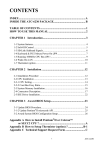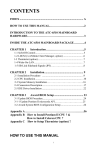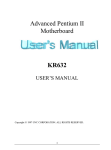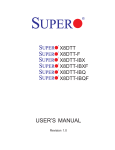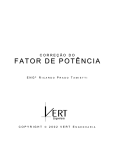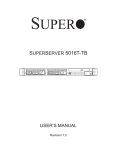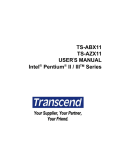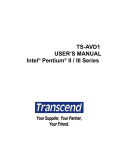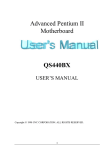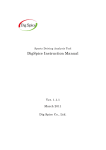Download Intel ATC6430M User's Manual
Transcript
How To Use This Manual ATC6430M Mainboard HOW TO USE THIS MANUAL This manual is written in a user-friendly style. It would be advisable for users to read it in an orderly sequence : 1. For Hardware Information: Read COMPONENT LOCATION DIAGRAM, Page A: QUICK JUMPER & CONNECTOR SETTING, Page B: Slot 1 and CPU Installation, Page C: CONNECTORS AND JUMPERS DESCRIPTION and Page D:List of Packaging. 2. For Mainboard and System Features: Read “Chapter 1 System Features” , and you will find helpful information on mainboard and system features. Especially, when you want to do some feature setup, detailed instructions are provided therein to help you through. 3. For CPU, Memory and Drivers Installation: Read “Chapter 2 Installation” for your CPU, memory and application drivers installation. Detailed instructions are provided to guide all kinds of users. 4. For BIOS Update and Setup: Read “Chapter 3 Award BIOS Setup” for updating your mainboard BIOS and setting up your BIOS Configuration. 5. For other Technical Support: Read “APPENDIX A”, fill and send the Request Form to your dealer for other technical support. The default settings on a mainboard is not necessarily what user expects. A user-friendly manual would be the handiest assistant to help change the on-board configuration or default setting. In case this manual cannot solve all your problems, please ask your dealer for help and be sure the warranty on your system is still valid. REMARK: Intel® is a registered trademark of Intel Corporation. All other brands and product names are registered trademarks of their respective companies ATC6430M Mainboard Contents CONTENTS QUICK JUMPER & CONNECTOR SETTING..........................A SLOT 1 AND PENTIUM II/III INSTALLATION...................B CONNECTORS AND JUMPERS DESCRIPTION....................C CHECKLIST OF PACKAGING................................................D HOW TO USE THIS MANUAL TABLE OF CONTENTS CHAPTER 1 System Features......................................................1 1-1 Introduction.................................................................... .......... 1 1-2 System Specifications ..................................................... ...........2 1-3 Features Highlight...................................................................... ...3 1-3-1 Add-on Features for VGA in Intel 810.................................4 1-3-2 Add-on Features for Audio...................................................4 1-3-3 AMR and AC'97 CODEC Controller...................................5 1-3-4 Software Power Off Control.................................................5 1-3-5 Modem Ring On...................................................................6 1-3-6 SB-Link Sideband Signal.....................................................6 1-3-7 Ultra DMA 66 Cable(Optional)............................................7 1-3-8 Wake-On-LAN......................................................................8 CHAPTER 2 Installation ..................................................................9 2-1 Installation Procedure .................................................... .............9 2-2 CPU Installation.............................................................. .............10 2-3 System Memory Installation ............................................ .............11 2-4 Intel 810 Driver Installation.............................................. .............12 2-5 VGA Driver Installation................................................... .............12 2-6 Sound Driver Installation................................................. .............12 CHAPTER 3 Award BIOS Setup...................................................13 3-1 Update BIOS Procedure...... ........................................... .............14 3-2 System BIOS Configuration Setup .................................. .............16 3-2-1 Standard CMOS Features......................................................................18 3-2-2 Advanced BIOS Features.......................................................................21 3-2-3 Advanced Chipset Features...................................................................24 3-2-4 Integrated Peripherals............................................................................26 Contents ATC6430 Mainboard 3-2-5 Power Management Setup......................................................................27 3-2-6 PNP/PCI Configuration..........................................................................31 3-2-7 PC Health Status ...................................................................................33 3-2-8 Frequency / Voltage Control...................................................................34 3-2-9Load Fail-Safe Defaults...........................................................................35 3-2-10 Load Optimized Defaults.................... ..................................................35 3-2-11SupervisorPassword/User Password......................................................35 3-2-12Save & Exit Setup.............................................................. ...................35 3-2-13Exit without Saving................................................................. ...............35 Appendix A Technical Support Request Form ATC6430M Mainboard Chapter 1 System Features CHAPTER 1 System Features 1-1 Introduction 6430M mainboard is designed to run with Intel 810 chipset to enhance the performance and extraordinary value of the Intel CeleronTM processor-powered PC. On the other hand, it is mounted with both Slot 1 and Socket 370 connector for users to make their CPU choice. It supports 66MHz, 100MHz and 133MHz Host Bus Intel PPGA CeleronTM CPUs. To enhance its peripheral support, 5 PCI slots are mounted on board, with an optional ISA slot to meet some exceptional users’ requirements. In addition to the incorporated VGA in Intel 810, its wide and inclusive add-on features are described one by one in later part of this chapter. Before that, let us see some architectural features of Intel 810. Chipset Combination FW82810DC100 / FW82810E + FW82801AA With 4MB Display cache Yes Supporting UDMA 66 Yes Shared Memory installing VGA driver After 7MB Users should check with your dealer for the right chipset type on your mainboard. 1 Chapter 1 System Features ATC 6430M Mainboard 1-2 System Specifications of 6430M Mainboard : CPU Support: u Single CPU, with both Slot 1 and PPGA Socket 370 on board for choice. u Supports CPU Clock 66MHz, 100MHz and 133MHz (133MHz support “Slot 1” socket only). CPU Clock Ratios from 3.0x to 8.0x (step 0.5x). u Supports CPUs : Pentium II 233MHz~450MHz, Celeron 300MHz~500MHz, and Pentium III 450MHz~650MHz. u CPU Core Voltage 1.30V~2.05V (step 0.05V), and 2.1V~3.5V (Step 0.1V); CPU~I/O Voltage 3.3V. u Built-in Switching Voltage Regulator, supporting Vcore autodetection. : Memory Support: u Two DIMM sockets on board supporting up to 512MB SDRAM. u PC-66 / PC-100 compatible. : I/O System u On-board Intel 810 Chipset for I/O Control: FW82810DC100 / FW82810E + FW82801AA. u Bus Frequency 66MHz/100MHz u 5 PCI slots on board, compliant with version 2.2 PCI Local Bus spec. u One Optional ISA slot. u One AMR (Audio, Modem Riser) slot on board. u Dual Master IDE connectors, supporting UDMA33/66 for 4 IDE devices such as high capacity HDD, CD-ROM, LS-120 and tape backup etc. u Two USB connectors in stack supporting up to 127 USB devices. u PS/2 Keyboad and PS/2 Mouse connectors. u One Infrared (IrDA TX/DX) connector. u One FDD port supporting two Floppy drives of : 1.2MB / 1.44MB / 2.88MB. u One parallel port for SSP/EPP/ECP mode printer. u Two 16550A Fast UART compatible connectors for serial and VGA port. u One Game /Midi port and 3 Audio Jacks for Speak-out, Line-in and Microphone-in. u One SB-Link Connector for Sound Card and PCI connection. 2 ATC6430M Mainboard Chapter 1 System Features : BIOS Support: u Built-in VGA BIOS in Intel 810; and built-in Keyboard BIOS;. u AWARD BIOS in Intel 810, providing CMOS Setup Utilities: - Standard CMOS Features Setup for Date, Drives and VGA ; - Advanced BIOS Features Setup for CPU Cache, Self Test, Boot Device, Typematic Rate , and Security Options etc.; - Advanced Chipset Features Setup for SDRAM CAS, RAS, System BIOS Cacheable, and Video BIOS Cacheable etc.; - Integrated Peripherals Setup for IDE Mode, USB, Audio, and Modem etc.; - Power Management Setup on Video, HDD, CPU etc.; - PnP/PCI Configurations Setup for PnP, Reset, Resources etc.; - PC Health Status Control and Setup; - Frequency / Voltage Control on CPU, SDRAM, PCI & SSC etc.; - Load Fail-Safe Defaults; - Load Optimized Defaults; - Set Supervisor/User Password; : Board Dimension :308mm x 202mm, in ATX form Factor. with one ATX Power Connector. 3 Chapter 1 System Features ATC 6430M Mainboard 1-3 Features Highlight 1-3-1 Add-on Features for VGA in Intel 810: : Integrated Graphics Controller u 3D Hyper Pipelined Architecture. u Full 2D H/W Acceleration. u Motion Video Acceleration. : 3D Graphics Visual Enhancements u Flat & Gouraud Shading. u Mip Maps with Bilinear and Anisotropic Filtering. u Fogging Atmospheric Effects. u Z Buffering. u 3D Pipe 2D Clipping. u Backface Culling. : 3D Graphics Texturing Enhancements u Per Pixel Perspective Correction Texture Mapping. u Texture Compositing. u Texture Color Keying/Chroma Keying. u Integrated 24-bit 230MHz RAMDAC. : 2D Graphics u Up to 1600 x 1200 in 8-bit Color at 85 Hz Refresh. u Hardware Accelerated Functions. : H/W Motion Compensation Assistance for S/W MPEG2 Decode u Software DVD at 30fps. u H/W Overlay Engine with Bilinear Filtering. 1-3-2 Add-on Features for Audio: : Intel 810 ICH with built-in AC’97 controller. : Supporting HRTF-based 3D positional audio, A3D, Q3D, wavetable, and 3D surround sound. Note: If you want to enable the onboard AC’97 CODEC, you need to set JP9 pin 2-3 closed. But in this way, the AMR slot will only accept a riser board with Modem CODEC and cannot accept another Audio Riser. 4 ATC6430M Mainboard 1-3-3 Chapter 1 System Features AMR and AC’97 CODEC Controller AMR slot and AC’97 CODEC are integrated into the Mainboard to enable audio and modem playback. AMR (Audio/Modem Riser) slot is mounted on board to connect riser board with Audio and/or Modem CODEC (AMC/AC/MC Adapters). The AMR specification developed by Intel provides a mechanism for AC’97 codes to be on a riser card. To enable the onboard AC’97 CODEC, set JP9 pin 2-3 closed. And in such way, you can further plug a riser board with Modem CODEC to the AMR slot. Otherwise, disabling onboard AC’97 CODEC by setting JP9 1-2 closed, you can plug a riser board with Audio/Modem CODEC to the AMR slot. See Page A for AMR location on 6430M Mainboard. 1-3-4 Software Power Off Control This mainboard supports Software Power Off Control feature through the SMM code in the BIOS under Windows 95/98, and MS-DOS operation system environment. First, you should connect the power switch cable to the connector “PS-ON” on the mainboard. In the BIOS screen of POWER MANAGEMENT SETUP’, choose “User Define” (or “Min. Power Saving” or “Max. Power Saving”) in ‘Power Management’. In Windows 95/98, if you want to power off the system, you just need to choose “shutdown the computer?” in the “Shut Down Windows” of Windows 95/98. Then the system power will be off directly, and stay at the stand-by status. If you want to restart the system, just press the power switch button.. Note : If you are going to leave your system idle for several days, we suggest you use hardware power off to shut down your system. Status Software power off control APM mode System running Power LED Light Light off Light on Light on Turbo LED Light Light off Light on Light on To locate “PS-ON” header, please see “Page A Quick Jumper & Connector Setting”. 5 Chapter 1 System Features ATC 6430M Mainboard 1-3-5 Modem Ring On With Modem Ring On function, the computer can wake up by remote signal through a connected modem. This function enables users to access their computer data from anywhere in the world. Users have to enable “Power On by Ring” in “Power Management Setup” of the AWARD BIOS setup screens. 1-3-6 SB-Link Sideband Signals In order to migrate the legacy Sound Blaster compatible audio to the PCI bus, EMU8008 incorporates a pair of SB-Link request/grant sideband signals (PCPCIR EQN and PCPCIGNTN) to interface to the PCI bus. SB-Link is a mechanism that was defined and developed by Intel as a docking solution which allows ISA slots to exist in docking stations connected to desktop PC PCI bus. SB-Link 2x3 sideband header, sound will also has a 2x3 header and a cable. PCI 5 REQ# SB Link PCI 4 6 GND SIRQ GNT#A GND ATC6430M Mainboard Chapter 1 System Features 1-3-7 Ultra DMA 66 Cable (optional) Ultra DMA 66 cable (40-pin connector & 80-line cable) is packaged while utilizing FW82801AA chip which supports both UDMA 33 & UDMA 66 on the mainboard. In other words, Ultra DMA 33 cable is only used with FW82801AB chip And the Ultra DMA 66 color coded connectors are shown as bellow: Blue to Mainboard Grey to Slave IDE Peripheral Black to Master IDE Peripheral 1-3-8 Wake-On-LAN The remote Wake-On-LAN (WOL) mode of operation is a mechanism that uses Advanced Micro Device Magic Packet technology to power on a sleeping workstation on the network. This mechanism is accomplished when the LAN card receives a specific packet of information, called a Magic Packet, addressed to the node on the network. For additional protection, Secure ON is an optional security feature that can be added to the Magic Packet that requires a password to power on the sleeping workstation. When LAN card is in remote Wake-On-LAN mode, main system power can be shut down leaving power only for the LAN card and auxiliary power recondition. The LAN card performs no network activities while in the remote Wake-On-LAN mode of operation. It only monitors the network for receipt of a Magic Packet. If a Magic Packet is addressed to the LAN card on the network, the LAN card wake up the system. If the Secure ON feature has been enabled, the password added to the Magic Packet is also verified prior to waking up the system. You should select two kinds of PCI Ethernet cards with WOL function. One is Intel and the other is with PME signal supporting. And you can set “PCI PME# 7 Chapter 1 System Features ATC 6430M Mainboard Function” enabled through “ Power Management Setup” from the BIOS setup screen. Caution: For Wake-On-LAN, the +5V standby line for the power supply should be capable of delivering +5V ± 5% at 720mA. Failure to provide adequate standby current when implementing Wake-On-LAN will damage the power supply. WOL connector + 8 6430M Mainboard Chapter 2 Installation CHAPTER 2 INSTALLATION 2-1 INSTALLATION PROCEDURE Before installing the computer, please prepare all components such as CPU, DRAM; peripherals such as hard drive, keyboard, CD-ROM and accessories such as cables. Then, install the system as following: - Put CPU / heat sink (refer to CeleronTM CPU installation guide or see the following setup chapter), and DRAM modules on the mainboard. Plug add-on cards into PCI slots, if needed. Connect cables to peripheral devices, especially for COM2 connector. Make sure all components and devices are well connected, turn on the power and setup System BIOS based on your configuration. Install peripheral devices, add-on card drivers and test them. If all of above procedures are running successfully, turn the power off and screw the chassis cover to the chassis. 9 Chapter 2 Installation 6430M Mainboard 2-2 CPU INSTALLATION This mainboard supports PPGA Socket 370 and Slot 1 processors. The 6430M mainboard has built-in Switching Voltage Regulator to support CPU Vcore autodetection. That is, It is smart enough to detect and recognize the CPU voltage, clock, ratio and enables users to set up the CPU frequency from the BIOS Setup Screen. Users can adjust the frequency through “Frequency / Voltage Control” of the BIOS Setup Screen. A. How to install CPUs for Socket 370: 1. Insert CPU Pin 1 to Pin 1 corner of Socket 370 and lock it. 2. Insert Slot 1"Terminator Kit" to Slot 1. CPU for Socket 370 " Terminator Kit" Pin 1 Corner Locking Lever Socket 370 B. How to install CPU for Slot 1: For Slot 1 CPU installation, please refer to “Page B Slot 1 installation” of this manual. 10 6430M Mainboard Chapter 2 Installation 2-3 SYSTEM MEMORY INSTALLATION 6430M mainboard provides two 3.3V 168-pin DIMM sockets for system memory expansion from 8MB to 512MB SDRAM. These two DIMMs are arranged to two banks, please refer to page A. Bank/DIMM PC-100 Memory Module Bank0/DIMM1 8/16/32/64/128/256MB Bank1/DIMM2 8/16/32/64/128/256MB Total System Memory Total Memory 8MB~256MB 8MB~256MB 8MB~512MB DIMM type, Size, parity supported: 6 6 6 6 PC-66/100 or higher performance memory module. Both parity or non-parity are available. 3.3V, single/double-side. 8/16/32/64/128/256Mbytes. u For either 66MHz , 100MHzand 133MHz host bus CPUs, please use 10ns or faster and PC-100 compliant modules . 11 Chapter 2 Installation 6430M Mainboard 2-4 INTEL 810 DRIVER INSTALLATION Ø INF Files for Windows 95/98 : 1. Start Windows 95/98. 2. Put the All-In-One CD into your CD-ROM drive. 3. Choose Intel 810/820 Inf Files on the Autorun main menu. 4. Then follow the instruction on the screen. (INF Files that enable the Intel 810/820 Chipsets to be recognized by listed operating systems.) 2-5 VGA DRIVER INSTALLATION Install Intel 810 AGP Driver For Win95/98/NT 1. Start Windows 95/98/NT. 2. Put the All-In-One CD into your CD-ROM drive. 3. Choose Intel 810 AGP Driver on the Autorun main menu. 4. Press Next to install the driver. 5. Follow the instructions on the screen to complete the installation. 2-6 SOUND DRIVER INSTALLATION Install Sound Driver For Win95/98/NT 1. Start Windows 95/98/NT. 2. Put the All-In-One CD into your CD-ROM drive. 3. Choose Audio Device Driver on the Autorun main menu. 4. Follow the instructions on the screen to finish the installation. (Please refer to readme.doc file to get more detailed information.) Install YAMAHA Software Synthesizer For Win95/98/NT 1. Start Windows 95/98/NT. 2. Put the All-In-One CD into your CD-ROM drive. 3. Choose YAMAHA Software Synthesizer on the Autorun main menu. 4. Follow the instructions on the screen to finish the installation. (Please refer to readme.doc file to get more detailed information.) Note : the sound driver is not supported under DOS operating system. 12 ATC6430M Mainboard Chapter 3 Award BIOS Setup CHAPTER 3 AWARD BIOS SETUP Award BIOS manufacturer provides access to the system BIOS through the hardware and software on mainboard. The hardware consists of a Flash ROM (4MB in 6430M mainboard) and the software is a group of programs that are installed in the ROMBIOS along with all the other data that should be included into the BIOS. After the BIOS is updated, if you want to clear the old setup data stored in the CMOS, then you can reset CMOS as follow. NOTE : In case CMOS should be reset,first unplug the power cord, then set Jumper 8 2-3 closed for at least 5 seconds, reset JP8 1-2 closed so as to return to normal position and plug the power cord again. JP8 1-2 2-3 Normal Reset CMOS 123 JP8 + PCI 1 Slot 13 Chapter 3 Award BIOS Setup ATC6430M Mainboard 3-1 UPDATE BIOS PROCEDURE 3-1-1 BIOS Update: If the BIOS needs to be updated, you can get a CD with the updated BIOS utility in the package. The CD includes : “awdflash.exe” -- BIOS update utility program “awdflash.doc” The update procedure is as following: 1. Boot the system to DOS mode in a normal manner. 2. Insert the updated CD to drive D (or E). 3. Change working directory to CD-ROM drive, D or E, which contains the update BIOS CD. -- Type “d:\” or “e: \”, then press “ENTER”. 4. Type “cd flash”, then press “ENTER”. 5. Type “awdflash”, then press “ENTER”-- for running the BIOS update utility. 6. Type “(update BIOS file name with version number).bin”, ENTER. 7. If you do not want to save the old BIOS, type “N” when the screen displays the message : " Do you want to save BIOS (Y/N) ?". 8. Type “Y“ when the screen shows the message : " Are you sure to program (Y/N) ?". 9. Follow instructions displayed on the screen. DO NOT remove the update BIOS CD from the CD-ROM drive nor turn the system power off until the BIOS update is completed. 10. Turn the power off. Clear the data in CMOS according to the procedure described in the previous page. 11. Turn the system power on and test that your system is working properly. 14 ATC6430M Mainboard Chapter 3 Award BIOS Setup 3-1-2 UPDATE MICROCODE API Intel also provides MICROCODE API (Applications Programming Interface) for mainboard user to update data block in BIOS quickly and easily. (You can find this utility in the All-In-One CD in the mainboard package). The BIOS code on the mainboards contains data that is specific to each silicon stepping of the processor. Integrators must ensure that this BIOS stepping data matches the used processor stepping. When the BIOS does not contain stepping data that matches the processor stepping, integrators must update the data in the BIOS before shipping the system. Historically, the systems have been updated by replacing the entire BIOS with a new revision of BIOS that contains the correct stepping data. Intel’s BIOS update API allows just the stepping data within the BIOS to be updated as needed. Mainboards that contain a BIOS with the Intel-defined BIOS update API can be quickly and easily updated, if required, without obtaining a complete BIOS upgrade. Using this utility, integrators can easily verify that the correct stepping data is present in all mainboards. However, if the stepping data requires to be updated, the mainboard BIOS must contain the Intel-defined BIOS update API, otherwise a complete BIOS upgrade is required from the mainboard vendor. Since API program can only be executed under DOS Real Mode, you must enter Real Mode first and load the API program to Drive C. To load the program to C by following steps: (1) Type “ md c:\ api ” and press Enter. Directory “api” is made in Drive C now. (2) Insert the Driver/Utility CD into CD ROM Drive E. (3) Then type “ copy e:\api\*.* c:\api ” and press Enter. (API program is loaded to Drive C now.) (4) Type “ C:\ api \checkup ” to execute this program. The main menu should now be displayed with the following four options : 1) Check and load update 2) Specify stepping data file [current : pep.pdb] 3) Help 4) Quit without loading update Select 1 to know the stepping filename, select 2 to load right patch code, then select 1 to update proper patch code. Now, the screen will show the message “please remove the CD from CD-ROM drive”. Then cold boot (mechanical power off) system to continue. For more information, please refer to “CHECKUP.HLP“ file. 15 Chapter 3 Award BIOS Setup ATC6430M Mainboard 3-2 SYSTEM BIOS CONFIGURATION SETUP The following pages explain how to set up the BIOS configuration under the Award BIOS. The SETUP program is stored in the Read-Only-Memory (ROM) on the mainboard. To do the SETUP procedure, press the <Del> key when the system is booting up. The following main menu will appear. Please select " STANDARD CMOS FEATURE" to enter the next screen. CMOS Setup Utility - Copyright ( C ) 1984-1998 Standard CMOS Feature Frequency/Voltage Control Advanced BIOS Feature Load Fail-Safe Defaults Advanced Chipset Feature Load Optimized Defaults Integrated Peripherals Set Supervisor Password Power Management Setup Set User Password PnP/PCI Configurations Save & Exit Setup PC Health Status Exit Without Saving ↑ ↓ ← → : Select Item Esc : Quit F10 : Save & Exit Setup Time, Date, Hard Disk Type…. The section at the bottom of the main menu explains how to control this screen. upper section displays the items highlighted in the list. 16 The ATC6430M Mainboard Chapter 3 Award BIOS Setup Control Key Description UP ARROW DOWN ARROW LEFT ARROW RIGHT ARROW Esc KEY Esc PgUp KEY PgDn KEY F1 KEY F5 KEY F6 KEY F7 KEY F10 KEY Help Old Value Load Fail-Safe Defaults Load Optimized Defaults Save & Exit Setup Move to the previous item Move to the next item Move to the item on the left Move to the item on the right Main Menu : Quit without saving changes Setup menu : Exit current page and return to main menu Increase the numeric value or make changes Decrease the numeric value or make changes General help Restore the pervious CMOS value from CMOS Load the fail-safe default CMOS value from BIOS default table Load the optimized default Save all the CMOS changes and Exit setup, only for Main Menu 17 Chapter 3 Award BIOS Setup ATC6430M Mainboard 3-2-1 STANDARD CMOS FEATURES This screen records some basic hardware information, and sets the system clock and error handling. These records can be lost or corrupted if the on-board battery has failed or is weak. CMOS Setup Utility – Copyright © 1984-1998 Award Software Standard CMOS Features Date: Time: Ø Ø Ø Ø IDE IDE IDE IDE Primary Master Primary Slave Secondary Master Secondary Slave Mon, Apr 26 1999 16:19:20 Press Enter Press Enter Press Enter Press Enter Item Help _____________________ None Menu Level Ø None None Change the day, month, None year and century Drive A 1.44M, 3.5 in. Drive B None Floppy 3 mode support Disabled Video Halt On EGA/VGA All Errors Based Memory Extended Memory Total Memory 640K 64512K 65536K ↑↓←→Move Enter: Select +/-/PU/PD: Value F10:Save ESC: Exit F1:General Help F5:Previous Values F6:Fail-safe defaults F7:Optimized Defaults Date day date month year . Allows user to change the day, month, year and century, with Y2K support. The day, from Sun to Sat, automatically changes when you set the date. The date, from 1 to 31 The month, Jan. through Dec. The year, from 1900 to 2099 Time The time format is <hour><minute><second>. , allowing user to set the internal clock. 18 ATC6430M Mainboard Chapter 3 Award BIOS Setup IDE Primary Master; Primary Slave Secondary Master; Secondary Slave Press Enter to enter next page for detailed hard drive settings: CMOS Setup Utility – Copyright © 1984-1998 Award Software IDE Primary Master IDE HDD Auto-Detection Press Enter Item Help Menu Level IDE Primary Master Capacity Access Mode Cylinder Head Precomp Landing Zone Sector Auto 2557 MB Auto 4956 16 0 4955 63 ØØ To auto-detect the HDD size, head.. on this channel ↑↓←→Move Enter: Select +/-/PU/PD: Value F10:Save ESC: Exit F1:General Help F5:Previous Values F6:Fail-safe defaults F7:Optimized Defaults IDE HDD Auto-Detection Press Enter to auto-detect the HDD. If detection is successful, it fills the remaining fields on this menu. IDE Primary Master If you select ‘Auto’, the BIOS will detect the HDD & CD-ROM Drive automatically at the POST stage and show the IDE for HDD & CD-ROM Drive. If you select ‘manual’, please contact your hard disk vendor or dealer to get the information listed below. Then enter the figure directly and press <Enter>. The following options are selectable only if the IDE Primary Master item is set to “Manual”. Cylinder number of cylinders Head number of read/write heads Precomp write precomp Landing Zone landing zone Sector number of sectors per track Capacity Displays your disk drive size. Access Mode Choose the access mode for the hard disk. The choices: Normal, LBA, Large, Auto. 19 Chapter 3 Award BIOS Setup ATC6430M Mainboard Drive A, Drive B This category identifies the types of floppy disk drive A or drive B that have been installed in the computer. None No floppy drive installed 360K, 5.25 in 5.25“ PC-type 360KB capacity 1.2M, 5.25 in 5.25“ AT-type 1.2MB capacity 720K, 3.5 in 3.5“ double-side 720KB capacity 1.44M, 3.5 in 3.5“ double-side 1.44MB capacity 2.88M, 3.5 in 3.5“ double-side 2.88MB capacity Floppy 3 Mode Support This is the Japanese standard floppy drive. This standard stores 1.2MB in a 3.5” diskette. Video To selects the type of primary video adapter used for the system monitor. EGA/VGA Enhanced Graphics Adapter/Video Graphics Array. For EGA, VGA, SEGA, SVGA or PGA monitor adapters CGA 40 Color Graphics Adapters, power up in 40 column mode CGA 80 Color Graphics Adapters, power up in 80 column mode MONO Monochrome adapter, includes high resolution monochrome adapters Halt On This category determines whether the computer will stop if an error is detected during power up. No errors The system boot will not be stopped for any error that may be detected. All errors When the BIOS detects a non-fatal error, the system will be stopped and you will be prompted. All, But The system boot will not stop for a keyboard error. It will stop for all Keyboard other errors. All, But The system boot will not stop for a floppy drive error. It will stop for all Diskette other errors. All, But The system boot will not stop for a floppy drive or keyboard error. It Disk/Key will stop for all other errors. Memory To display what is detected by POST (Power On Self Test) of the BIOS. Base Memory The POST will determine the amount of base (or conventional) memory installed in the system. The value of the base memory is typically 512K or 640K based on the memory installed on the motherboard. Extended Memory How much extended memory is present during the POST. This is the amount of memory located above 1MB in the CPU‘s memory address map. Total Memory Displays the total memory available in the system. 20 ATC6430M Mainboard Chapter 3 Award BIOS Setup 3-2-2 ADVANCED BIOS FEATURES This screen is a list of system configuration options. Some of them are defaults required by the mainboard’s design, others depend on the features of your system. CMOS Setup Utility – Copyright © 1984 – 1998 Award Software Advanced BIOS Features Virus Warning Disabled CPU L1 Cache Enabled CPU L2 Cache Enabled CPU L2 Cache ECC Checking Enabled xProcessor Number Feature Quick Power On Self Test First Boot device Second Boot device Third Boot device Boot other device Swap Floppy Drive Boot Up Floppy Seek Boot Up NumLock Status Gate A20 Option Typematic Rate Setting xTypematic Rate (Chars/Sec) xTypematic Delay (Msec) Security Option OS Select For DRAM > 64MB HDD S.M.A.R.T. Capability Report No FDD for Win 95 N/A Enabled Floppy HDD-0 SCSI Enabled Disabled Enabled On Fast Disabled 6 250 Setup Non-OS2 Disabled Item Help ______________________ _ Menu Level Ø Allows you to choose the VIRUS warning feature for IDE Hard Disk boot sector protection. If this function is enabled and someone attempt to write data into this area, BIOS will show a warning message on screen and alarm beep No ↑↓←→Move Enter: Select +/-/PU/PD: Value F10:Save ESC: Exit F1:General Help F5:Previous Values F6:Fail-safe defaults F7:Optimized Defaults Virus Warning Allows user to choose the VIRUS warning feature for IDE Hard Disk boot sector protection. If this function is enabled and someone attempts to write data into this area, BIOS will show a warning message on screen and alarm beep. ! WARNING ! Disk boot sector is to be modified Type ‘Y’ to accept write or ‘N’ to abort write Award Software, Inc. CPU L1 Cache, L2 Cache These two categories speed up memory access. However, it depends on CPU design. The default value is ‘Enabled‘. 21 Chapter 3 Award BIOS Setup ATC6430M Mainboard CPU L2 Cache ECC Checking If Enabled, this function will do ECC check to CPU L2 Cache automatically. Quick Power On Self Test This category speeds up Power On Self Test while booting. If “Enabled”, BIOS will skip some items under check by POST. First Boot Device, Second Boot Device, Third Boot Device, Boot Other Device Allows user to select the Boot Device Priority. The choices: Floppy, LS/ZIP/, HDD, SCSI, CDROM, Disabled. Swap Floppy Drive If the system has two floppy drives, choose “Enabled” to assign the physical drive B to logical drive A and vice-versa. Boot Up Floppy Seek have 40 or 80 tracks. “Enabled” will test floppy drives and determine whether they Boot Up NumLock Status This allows you to determine the default state of the numeric keypad. By default, the system boots up with NumLock on. On Keypad is for numeric keys Off Keypad is for arrow keys Gate A20 Option This entry allows you to select how the gate A20 is handled. The gate A20 is a device used to address memory above 1 MB. If “Normal”, keyboard is controlled by a pin in keyboard controller. If “Fast”, it is controlled by chipset. Typematic Rate Setting Keystrokes repeat at a rate determined by the keyboard controller. When “Enabled”, the typematic rate and typematic delay can be selected. Typematic Rate (Chars/Sec) When the typematic rate is enabled, this item will appear to allow you to select the key repeat rate. 6 means 6 characters per second. Typematic Delay (Msec) When the typematic rate is enabled, this item will appear to allow you to set the delay time before key strokes begin to repeat. 250: 250 msec (500,750,1000) Security Option This category allows you to limit access to the system and Setup, or just to Setup. Options: System Password is then required every time the system boots. Setup The system will boot without password, but access to Setup requires correct password. 22 ATC6430M Mainboard Chapter 3 Award BIOS Setup OS Select for DRAM > 64MB This item allows you to access the memory that is over 64MB in OS/2. The choice : Non-OS2, OS2 HDD S.M.A.R.T. Capability Select Enabled if your Hard disk supports S.M.A.R.T.(Safe-Monitoring Analysis and Reporting Technology) function. Report No FDD For WIN 95 Set this item to Yes, BIOS will report FDD to Win95. If in standard CMOS setup, set Drive A to none and set this item to “Yes”, inside Win95, My Computer and File manager Disk(A:) will show Removable Disk (A:). 23 Chapter 3 Award BIOS Setup ATC6430M Mainboard 3-2-3 ADVANCED CHIPSET FEATURES This screen controls the setting for the chipset on the mainboard. This chipset manages bus speeds and access to system memory resources. CMOS Setup Utility – Copyright © 1984 – 1998 Award Software Advanced Chipset Features SDRAM CAS Latency Time 3 Item Help SDRAM Cycle Time Tras/Trc 6/8 ____________________ SDRAM RAS-to-CAS Delay 3 _ SDRAM RAS Precharge Time 3 System BIOS Cacheable Enabled Menu Level Ø Video BIOS Cacheable Enabled Memory Hole At 15M-16M Disabled Delay Transaction Enabled On-Chip Video Window Size 64MB * Onboard Display Cache Setting * CAS# Latency 3 Paging Mode Control Close RAS-to-CAS Override By CAS# LT RAS# Timing Slow RAS# Precharge Timing Slow ↑↓←→Move Enter: Select +/-/PU/PD: Value F10:Save ESC: Exit F1:General Help F5:Previous Values F6:Fail-safe defaults F7:Optimized Defaults 24 ATC6430M Mainboard Chapter 3 Award BIOS Setup SDRAM CAS Latency Time When synchronous DRAM is installed, the number of clock cycles of CAS latency depends on the DRAM timing. The choices: 2,3. “2” gives faster performance and “3” gives more stable performance. SDRAM Cycle Time Tras/Trc Select the number of SCLKs for an access cycle. “5/7” gives faster performance and “6/8” gives more stable performance. SDRAM RAS-to-CAS Delay This field lets you insert a timing delay between the CAS and RAS strobe signals, used when DRAM is written to, read from, or refreshed. “2” gives faster performance and “3” gives more stable performance. This field applies only when synchronous DRAM is installed in the system. SDRAM RAS Prechage Time If an insufficient number of cycles is allowed for the RAS to accumulate its charge before DRAM refresh, the refresh may be incomplete and the DRAM may fail to retain data. This field applies only when synchronous DRAM is installed in the system. System BIOS Cacheable Selecting Enabled allows the caching of the system BIOS ROM area, resulting in better system performance. However, if any program writes to this memory area, a system error may result. Video BIOS Cacheable Selecting Enabled allows the caching of the video BIOS ROM area, resulting in better system performance. However, if any program writes to this memory area, a system error may result. Memory Hole At 15M-16M Certain space in memory can be reserved for ICH/ICH0. Delay Transaction This chipset has an embedded 32-bit posted write buffer to support delay transactions cycles. Select Enabled to support compliance with PCI specification version 2.1. The choice : Enabled, disabled space On-chip Video Window Size Determine the size of memory space that can be allocated for on-chip graphics device. The following items are optional for onboard display cache setting: CAS# Latency The number of clock cycles of CAS latency depends on the Display Cache timing. The choices: 2,3. “2” gives faster performance and “3” gives more stable performance. Paging Mode Control Close: the GMCH will precharge all during the service of a 25 Chapter 3 Award BIOS Setup ATC6430M Mainboard page miss. Open: it will precharge bank during the service of a page miss. RAS-to-CAS Override By CAS# LT: the RAS-to-CAS delay timing will be the same as item of CAS# Latency. Override: the value will be fixed in 2. RAS# Timing This item controls the active time of RAS# and bank cycle time. “Fast” gives faster performance and “Slow” gives more stable performance. RAS# Precharge Timing If an insufficient number of cycles is allowed for the RAS to accumulate its charge before DRAM refresh, the refresh may be incomplete and the DRAM may fail to retain data. “Fast” gives faster performance and “Slow” gives more stable performance. 26 ATC6430M Mainboard Chapter 3 Award BIOS Setup 3-2-4 INTEGRATED PERIPHERALS This section page includes all the items of IDE hard drive and Programmed Input/Output features. See also Section “Chipset Features Setup”. CMOS Setup Utility – Copyright © 1984 – 1998 Award Software Integrated Peripherals OnChip Primary PCI IDE OnChip Secondary PCI IDE IDE Primary Master PIO IDE Primary Slave PIO IDE Secondary Master PIO IDE Secondary Slave PIO IDE Primary Master UDMA IDE Primary Slave UDMA IDE Secondary Master UDMA IDE Secondary Slave UDMA USB Controller USB Keyboard Support Init Display First AC97 Audio AC97 Modem IDE HDD Block Mode Power On Function xKB Power On Password xHot Key Power On Onboard FDC Controller Onboard Serial Port 1 Onboard Serial Port 2 UART Mode Select xUART Duplex Mode Onboard Parallel Port Parallel Port Mode ECP Mode Use DMA PWRON After PWR-Fail Game Port Address Midi Port Address xMidi Port IRQ CIR Port Address xCIR Port IRQ Enabled Enabled Auto Auto Auto Auto Auto Auto Auto Auto Enabled Disabled PCI Slot Auto Auto Enabled Button Only Enter Ctrl-F1 Enabled 3F8/IRQ4 2F8/IRQ3 Normal Half 378/IRQ7 ECP 3 Off 201 Disabled 7 Disabled Item Help _____________________ _ Menu Level Ø If your IDE hard drive supports block mode select Enabled for automatic detection of the optimal number of block read/write per sector the drive can support 11 ↑↓←→ Move Enter: Select +/-/PU/PD: Value F10:Save ESC: Exit F1:General Help F5:Previous Values F6:Fail-safe defaults F7:Optimized Defaults On-Chip Primary PCI IDE; On-Chip Secondary PCI IDE This setup item allows you to either enable or disable the primary/secondary controller. You might choose to disable the controller if you want to add higher performance or specialized controller. IDE Primary Master/Slave PIO IDE; Secondary Master/Slave PIO PIO - Programmed Input/Output, it allows the BIOS to tell the controller what it wants and then let the controller and the CPU to complete the task by themselves. This is 27 Chapter 3 Award BIOS Setup ATC6430M Mainboard simpler and faster. Your system supports five modes, 0 - 4, which primarily differ in timing. When Auto is selected, the BIOS will select the best available mode. IDE Primary Master/Slave UDMA; IDE Secondary Master/Slave UDMA Auto, will support the Ultra DMA function. Disabled, will not support the Ultra DMA function. USB Controller This item allows you to decide to enable/disable the USB controller. USB Keyboard Support Enabled will support USB keyboard in Win95 2.1 and NT 5.0 or above operating system. Init Display First This item allows you to decide to activate PCI VGA or on-chip VGA first. The choice: PCI Slot, Onboard. AC97 Audio; AC 97 Modem This item allows you to decide to enable/disable the i810 chipset family to support AC97 Audio/Modem. IDE HDD Block Mode This allows your HD controller to use the fast block mode to transfer data to and from your HD drive. Enabled IDE controller uses block mode Disabled IDE controller uses standard mode Power On Function This function supports 7 “Power On “ modes : Password, Hot Key, Mouse Move, Mouse Click, Any Key, Button Only, and Keyboard 98. Default is “Button Only”. If “Password” is chosen, the item “KB Power On Password” will appear to ask you to enter password. If “Hot Key” is chosen, the item “Hot Key Power On” will appear to ask you to pick the Hot Key. On Board FDC Controller controller. This item will enable or disable the floppy disk On Board Serial Port 1 User can select serial port IRQ. If set to Auto, system will assign an IRQ for it. Note : set to Auto is not recommended. On Board Serial Port 2 User can select serial port IRQ. If set to Auto, system will assign an IRQ for it. Note : set to Auto is not recommended. 28 ATC6430M Mainboard Chapter 3 Award BIOS Setup UART Mode Select This lets you select the Infrared mode. Choices are IrDA, ASKIR, Normal, and SCR. Only when you choose IrDA or ASKIR , the screen will then show “UART2 Duplex Mode’ for you to choose “Full” or “Half”.. On Board Parallel Port Let user select IRQ for parallel port When Disabled, the parallel port will be disabled. Parallel Port Mode Let user select Parallel Port : SPP, EPP, ECP, ECP+EPP ECP Mode Use DMA Select a DMA channel for the port. Choices are 3, 1. PWRON After PWR-Fail Allows you to choose “Off”, On, former-Status”. Game Port Address; Midi Port Address The IO address of Game Port/Midi Port. If Midi Port is fixed, the item “Midi Port IRQ” will appear for setting. CIR Port Address Allows you to fix the Consumer Infrared Device Port Address. If fixed, the item “CIR Port IRQ” will appear for setting. 29 Chapter 3 Award BIOS Setup ATC6430M Mainboard 3-2-5 POWER MANAGEMENT SETUP This screen controls the 'green' features of this mainboard. CMOS Setup Utility – Copyright © 1984 – 1998 Award Software Power Management Setup ACPI function Power Management Video Off Method Video Off In Suspend Suspend Type MODEM Use IRQ Suspend Mode HDD Power Down Soft-Off by PWRBTN PCI PME# Function Power On by Ring CPU Thermal-Throttling Resume by Alarm Enabled Item Help User Define ____________________ DPMS Yes Menu Level Ø Stop Grant 3 Disabled Disabled Instant Off Disabled Enabled 50.0% Disabled ** Reload Global Timer Primary IDE 0 Primary IDE 1 Secondary IDE 0 Secondary IDE 1 FDD, COM, LPT Port PCI PIRQ [A-D]# Events ** Disabled Disabled Disabled Disabled Disabled Disabled ↑↓←→Move Enter: Select +/-/PU/PD: Value F10:Save ESC: Exit F1:General Help F5:Previous Values F6:Fail-safe defaults F7:Optimized Defaults ACPI function This item is to set the ACPI ( Advanced Configuration Power Interface ) function enabled or disabled. Power Management This category allows you to select the type (or degree) of power saving and is directly related to the following modes : Suspend; HDD Power Down. Disabled No power management. It means all 4 modes are disabled. Min. Power Minimum power management. Doze =1hr.; Standby=1hr.; Saving Suspend=1hr.; HDD Power Down=15min Max. Power Saving User Define Maximum power management Doze=1min.; Standby=1min.; Suspend=1min.;HDD Power Down=1min Allows you to set each mode individually. When not disabled, each of the ranges are from 1min. to 1hr. except for HDD Power Down which ranges from 1 to 15min. and disable 30 ATC6430M Mainboard Video Off Method V/H SYNC + Blank Blank Screen DPMS Chapter 3 Award BIOS Setup This determines the manner in which the monitor is blanked. This selection will cause the system to turn off the vertical and horizontal sync. ports and write blanks to the video buffer. This option only writes blanks to the video buffer. Initial of “Display Power Management Signaling”. Video off In Suspend This determines the manner in which the monitor is blanked. Suspend Type Select the suspend type. Stop Grant Only CPU enters sleeping mode Full on Suspend Both CPU and chipset enter sleeping mode MODEM Use IRQ This item determines the IRQ in which the MODEM can be used. The choice : 3,4,5,7,9,10,11,NA. Suspend Mode When enabled and after the set time of system inactivity, all devices except the CPU will be shut off. HDD Power Down When enabled and after the set time of system inactivity, the hard disk drive will be powered down while all other devices remain active. Soft-Off by PWR-BTTN Instant-off : When push the power button, the system power will be off immediately. Delay 4 sec : when push the power button, it will enter suspend mode. We need to push the power button and hold it for 4 seconds to turn off the power. PCI PME# Function With PCI card supporting PCI Power Management capability and this item setting to Enabled, the system can be waked up by PCI card. PowerOn by Ring Enabled: when system is in suspend mode, it can be waked up by modem. Disabled: it cannot be waked up by modem. Resume by Alarm When Enabled, two additional lines will be added to the screen :Date (of Month) Alarm; Time (hh:mm:ss) Alarm to let user set the desired date and time. After power off, the system will automatically power on at the specified date and time. Reload Global Timer Events When enabled, an event occurring on each device listed below restarts the global time for Standby mode. IRQ [3-7, 9-15], NMI; Primary IDE 0; Primary IDE 1; Secondary IDE0; Secondary IDE1; Floppy Disk; Serial Port; Parallel Port. 31 Chapter 3 Award BIOS Setup ATC6430M Mainboard 3-2-6 PNP/PCI CONFIGURATION This screen configures the PCI Bus slots. CMOS Setup Utility – Copyright © 1984-1998 Award Software PnP/PCI Configurations PNP OS Installed Reset Configuration Data No Item Help -------------------Disabled Menu Level Ø Resources Controlled By Auto Select “Yes” if you are Ø IRQ Resources Press Enter using a Plug and Play OS. Ø DMA Resources Press Enter Select NO if you need the Ø Memory Resources Press BIOS to confirm Enter non-boot device. PCI/VGA Palette Snoop Disabled ↑↓←→Move Enter: Select +/-/PU/PD: Value F10:Save ESC: Exit F1:General Help F5:Previous Values F6:Fail-safe defaults F7:Optimized Defaults PNP OS Installed Select “Yes” if you are using a Plug nad Play OS. Select “No” if you need the BIOS to confirm non-boot device. Reset Configuration Data This item allows you to determine whether to reset the configuration data or not. Resource Controlled by The Award Plug and Play BIOS has the capability to automatically configure all of the boot and Plug & Play compatible devices. However, this capability means absolutely nothing unless you are using a Plug and Play OS such as Windows 95. Choices are Auto and Manual. IRQ Resources; DMA Resources When resources are controlled manually, assign each system interrupt/DMA channel a type, depending on the type of device using the interrupt/DMA channel. IRQ3/4/5/7/9/1011/12/14/15, DMA0/1/3/5/6/7 Assign to This item allows you to determine the IRQ/DMA assigned to the ISA bus and is not available to any PCI slot. Choices are Legacy ISA and PCI/ISA PnP. Memory Resources “Memory Resources” has two events: Resources Memory Base N/A 32 ATC6430M Mainboard Memory Resources Chapter 3 Award BIOS Setup Length 8K 33 Chapter 3 Award BIOS Setup ATC6430M Mainboard PCI/VGA Snoop It determines whether the MPEG ISA/VGA cards can work with PCI/VGA or not. Enabled When PCI/VGA working with MPEG ISA/VGA Card Disabled When PCI/VGA not working with MPEG ISA/VGA Card 34 ATC6430M Mainboard Chapter 3 Award BIOS Setup 3-2-7 PC Health Status This screen shows your in-use PC Health Condition: CMOS Setup Utility – Copyright © 1984-1998 Award Software PC Health Status Vcore +2.5V +3.3V +5V +12V -12V +1.8V VTT(V) Voltage Battery CPU Temperature System Temperature CPU Fan Speed Chassis Fan Speed CPU Warning Temperature Shutdown Temperature Item Help ------------------Menu Level Ø 700C/1580F 900C/1940F ↑↓←→ Move Enter: Select +/-/PU/PD: Value F10:Save ESC: Exit F1:General Help F5:Previous Values F6:Fail-safe defaults F7:Optimized Defaults Vcore---Chassis Fan Speed CPU Warning Temperature Shutdown Temperature These items are to show the in-use PC conditions. Default temperature is 700C/1580F. Default temperature is 900C/1940F. 35 Chapter 3 Award BIOS Setup ATC6430M Mainboard 3-2-8 FREQUENCY / VOLTAGE CONTROL This screen controls the 'green' features of this mainboard. CMOS Setup Utility – Copyright © 1984-1998 Award Software Frequency/Voltage Control Auto Detect DIMM/PCI CLK Disabled CPU/SDRAM/PCI Clock & SSC Default CPU Ratio X 3 Item Help ------------------Menu Level Ø ↑↓←→ Move Enter: Select +/-/PU/PD: Value F10:Save ESC: Exit F1:General Help F5:Previous Values F6:Fail-safe defaults F7:Optimized Defaults Auto Detect DIMM/PCI ClK If this item is enabled, the unused DIMM and PCI slot clock will be disabled. If this item is disabled the unused DIMM and PCI slot will still get the active clock signal. CPU/SDRAM/PCI Clock & SSC Use this item to set CPU base clock frequency and Spread Spectrum clocking function.. The optimized range of combinations are : CPU SDRAM PCI SSC 66~155MHz 100~155MHz 33~38MHz On/Off After you change the CPU Clock Frequency and the system can not start, please do the following procedures: 1. Turn the system off firstly. 2. Turn on the system. Then press and hold the “ Insert ” key at boot. 3. Select the proper figure in the item of CPU/SDRAM/PCI Clock. Save and Exit Setup. CPU Ratio Use this item to set CPU ratio which includes x 3 x 3.5 x 4 x 5 x 5.5 x 6 x 6.5 x 7 x 7.5 and x 8. 36 x 4.5 ATC6430M Mainboard Chapter 3 Award BIOS Setup 3-2-9 LOAD FAIL-SAFE DEFAULTS When your mainboard has problems and needs to trouble shoot the system, you can use this function. The default values loaded only affect the BIOS Features Setup, Chipset Features Setup, Power Management Setup and PNP/PCI Configuration Setup. There is no effect on the Standard CMOS Setup. To use this function, select it from main menu and press <Enter>. A line will appear on the screen asking if you want to load the fail-safe default values. Press <Yes> and <Enter> then the BIOS default values will be loaded. 3-2-10 LOAD OPTIMIZED DEFAULTS This allows you to load optimal settings which are stored in the BIOS ROM. The default values loaded only affect the BIOS Features Setup, Chipset Features Setup, Power Management Setup and PNP/PCI Configuration Setup. There is no effect on the Standard CMOS Setup. To use this function, select it from main menu and press <Enter>. A line will appear on the screen asking if you want to load the optimized default values. Press <Yes> and <Enter> then the Setup default values will be loaded. 3-2-11 SUPERVISOR PASSWORD / USER PASSWORD This allows you to set the password. The mainboard defaults with password disabled. If you set both supervisor and user passwords, only the supervisor password allows you to enter the BIOS SETUP program. Enter/Change password : Enter the current password. And at the prompt, key-in your new password (up to eight alphanumeric characters), then press <Enter>. At the next prompt, confirm the new password by typing it again and press <Enter>. Disable password : Press the <Enter> key instead of entering a new password when the ‘Enter Password’ dialog box appears. A message will appear for confirming that the password is disabled. CAUTION: If you forget your password, you must clear CMOS first and restart system so as to set up password again. See “Reset CMOS” on Page 12. 3-2-12 SAVE & EXIT SETUP This allows you to save the new setting values in the CMOS memory and continue with the booting process. If you select this item and press 'Y', then these records will be saved in the CMOS memory on the mainboard. It will be checked every time you turn your computer on. 3-2-13 EXIT WITHOUT SAVING This allows you to exit the BIOS setup utility without recording any new values or changing old ones. 37











































